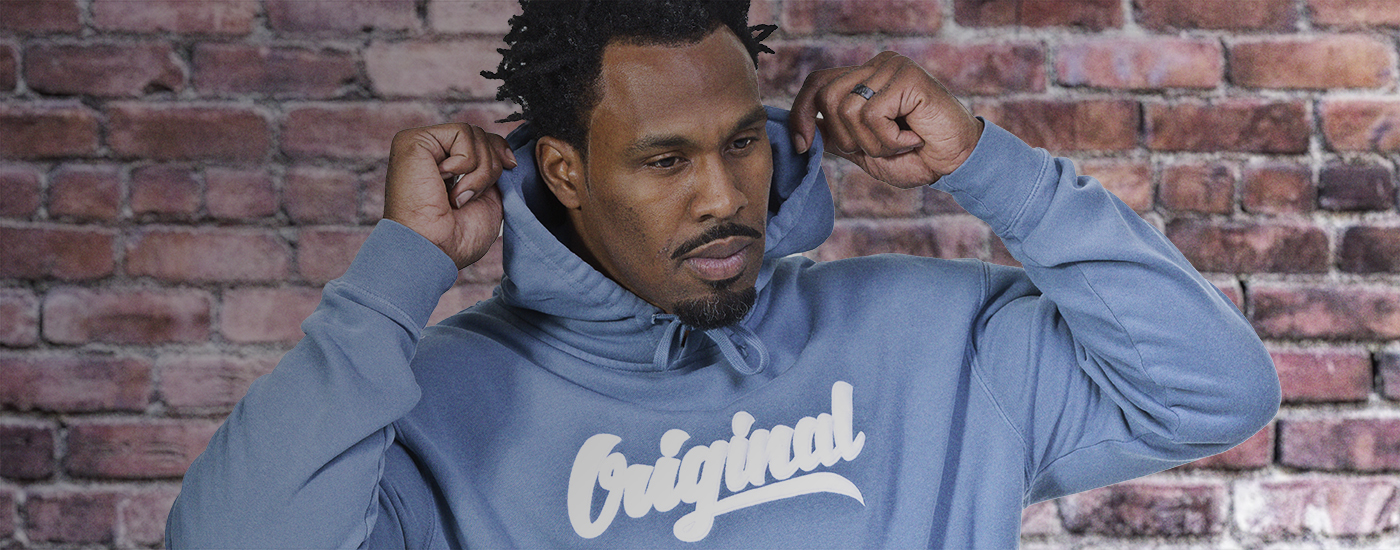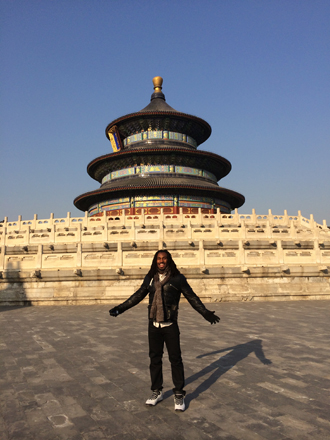 One of the reasons I’ve become so fascinated with Asia over the last few years is the way that culture and history are valued there. Many countries there have held onto their traditions and legacies for more that 5,000 years, and continue to honor them.
One of the reasons I’ve become so fascinated with Asia over the last few years is the way that culture and history are valued there. Many countries there have held onto their traditions and legacies for more that 5,000 years, and continue to honor them.
That was the case in a lot of places in China — including Beijing, which was my next stop after leaving Tokyo.
I was there for three days, and spent them in three different places. On the first day in Beijing, I had a chance to see the Temple of Heaven, which is a place where the Emperor would go, alone, to reflect and talk to God about how he wanted to rule over his people, and how far he wanted to take his reign in China.
You’re now allowed to go inside because it is protected for preservation, but you could stand at the base, and look inside through the doors and see the walls and the designs. There were a lot of mosaics. When you think about the time and effort put into those things, it’s impressive. I don’t think people would have the time, the patience, nor the resources to build that kind of stuff these days.
THE GREAT WALL
The next day we went over to the Great Wall of China, which was definitely one of the highlights of the trip.
We all know it’s one of the Seven Wonders of the World. It’s a massive wall that stretches more than 13,000 miles. I think it can be seen from space, actually. I also learned that it was built for protection to try to keep out the Mongolian Warriors.
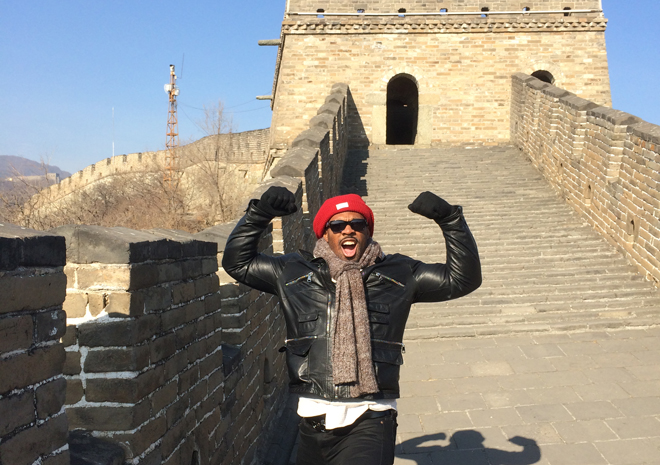
Like Mount Fuji in Japan, there are very few tourists there at this time of year, so at the part of the wall we explored, it was just me and my guide.
I got to hike two miles of it, and that was fun. It’s not a flat hike by any means. It’s very hilly because the wall is going up and down the peaks of natural mountains.
From just that little hike and realizing I didn’t even put a dent in the wall’s distance, I got a sense of how large it is. I also got a sense of how large my feet are because there’s a lot of climbing up stairs when you’re hiking along the wall, and those steps are not made for someone with a size 13 shoe. Thankfully, the area I hiked had been worked on a little bit, so there was not as much loose ground or loose footing as I expected. That was a comfort.
As I hiked, I enjoyed taking in all that history. You just start thinking about all the labor that went into it and the people that sacrificed themselves to put up this wall, and how they were able to build it. It was an environment that breeds deep thinking when you’re there alone, so it was a nice getaway.
I learned how to say my first Chinese phrase while at the Great Wall. My tour guide taught me that “wǒ ài nǐ” is “I love you.”
She just pointed at the wall for wǒ, then she pointed at the eye for ài and then she pointed at my knees for nǐ. So that’s how I learned that phrase. It helped it to stick in my head.
I also learned how to say very basic things like “good morning” and “hello.” (Those were useful when I would walk into a restaurant, or was walking around in the hotel.)
SEEING THE CITY
The last day in Beijing, we headed over to the downtown area and that was very busy. Nothing like I saw in Tokyo.
It was some of the worst traffic I’ve ever seen. I was surprised. I guess I just didn’t expect China to be as modern as it is, particularly in cities like Beijing and Shanghai.
But they are major cities of 20-25 million people. It’s incredible. There are 1.3 billion people in that country, and many of them work in the cities they live in. There are people all over the place.
They’re also just now starting to have a booming middle class. Everyone’s starting to get cars, and there’s just millions of cars on the road. You can’t go anywhere, at least not fast. If you have to be somewhere, you literally have to act like you’re going to the airport and leave like two hours in advance just to get someplace on time.
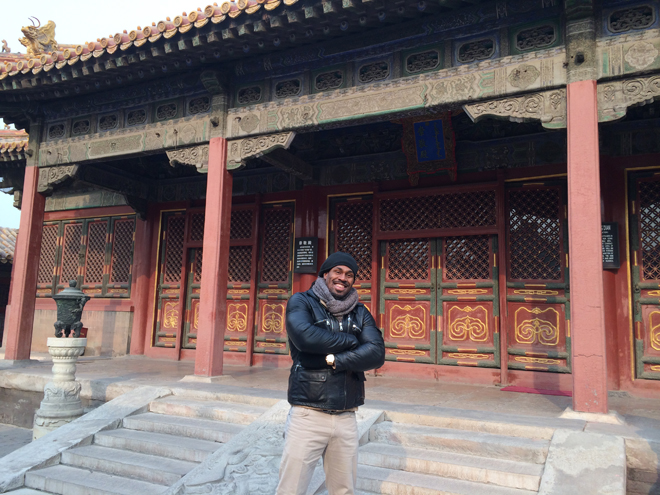
They have mass transit, but it’s more for people who travel in and out of the city for work, not for getting around the city itself. I was staying in the city so I found it was easier for me to just walk to where I wanted to go than to try to hop in a car.
The architecture there was really cool though. China is going through a whole facelift, constructing some of the world’s tallest buildings and very modern high rises. You also see some of the newest, finest foreign cars.
But they’ve also done a good job of holding onto their history. In Beijing, you’ll have a temple that’s 2,000 years old across the street from a brand new skyscraper.
Honestly though, I think the most beautiful structure in Beijing is the Bird’s Nest, the stadium they used for the 2008 Olympics. It’s a building that everyone’s seen, but being there and getting to see it close up from the outside, you get a better appreciation. It’s a stunning piece of art.
I didn’t get many souvenirs from the trip. I think I’ll mostly use the photos I took for that purpose, but I did end up getting a beautiful wood carving plate in China. On the plate, there is a scene of what it used to look like in China thousands of years ago with a forest of trees and the rivers flowing. I love things like that, and I try to buy art like that wherever I visit. I was also looking for a nice vase in China to put in one of my nooks at home, but could not find one this time. But I’m sure I’ll be back.
The carving plate was pretty much the extent of my shopping in Beijing. They have everything you can imagine for shopping there, but nothing I could find that fit me. I went into a couple stores early on in my trip, and people literally would just be like, “We don’t have anything for you.” But it probably helped me in the long run not being able to buy anything.
While I was in Japan, I ate salad and got a little sick on a tomato, so after that, I was nursing myself back to health and didn’t venture off too deeply as far as the cuisine goes. Getting sick like that made me a little nervous, so I stuck to just eating strictly food from the hotel for a little bit.
UNEARTHING AN ARMY
After spending three days in Beijing, I headed over to Xi’an, which is a very unique place in China. It’s where the Terracotta Warriors were found.
Back in ancient China, the first emperor, Qin Shi Huang, believed that he was going to rule in the afterlife, so he personally had carvings made up of all these different warriors and horses to defend his empire.
Thousands of years later, in the 1970s, a farmer in Xi’an was digging for crops on his land, and he came across these carvings and got scared. The site was excavated and they found thousands and thousands of these hand-carved sculptures of the Terracotta Warriors.

They believe that the carvings feature the actual faces of the people who worked and served the Emperor thousands of years ago. They carved every soldier, every horse, every common worker. So when you visit there, you’re actually looking at these four-foot or five-foot statues, and they’ve all got different personalities and different facial structures. It’s incredible.
They’re still excavating right now and haven’t uncovered everything. They’ve uncovered two sections of it and have a third one that they haven’t right now because they’re trying to figure out a better way to preserve them. The statues actually have colors, but due to the excavation and the exposure to oxygen, the colors have worn off some of them.
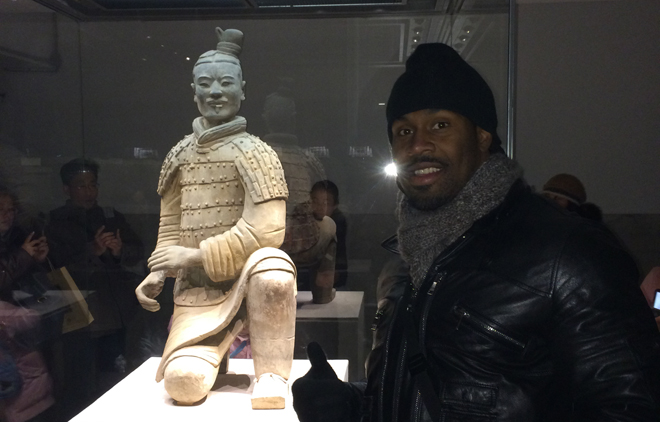
It’s really interesting to think that this Emperor really thought he was going to reign in the afterlife. He was so concerned about making sure he had his warriors so he would stay just as strong and as powerful in the afterlife as he was during his life on earth. Very weird. But it’s also cool.
It’s one of those things about ancient art and culture that we don’t have here in America.
PANDAS AND PEOPLE
After we saw the Terracotta Warriors in Xi’an, I went over to Chengdu, where I had a chance to go visit the world famous panda bears.
I don’t know what it is with me. I don’t even own any pets at home, but every time I go on these trips, I want to be up close and personal with these wild animals. This time it was a panda bear. Three years ago it was great whites. When I went to Australia, I spent time with kangaroos. Last year it was the elephants. I’m running out of animals. But it’s very enjoyable each time.
The panda bears were awesome. I had a good time learning about them, their environment and their habitat. I also learned some of what is being done to promote awareness that they are an endangered species. It’s a bear that the Chinese take a lot of pride in, and they’re doing all they can to preserve it.
I even got to feed one of them a carrot. If you’ve fed like a horse or anything, you know how you can just feel the hotness of their breath. It’s nerve wracking. As they continue chewing on the carrot, and you feel the need pull your hand back really fast, because you can sense how powerful their jaws are.
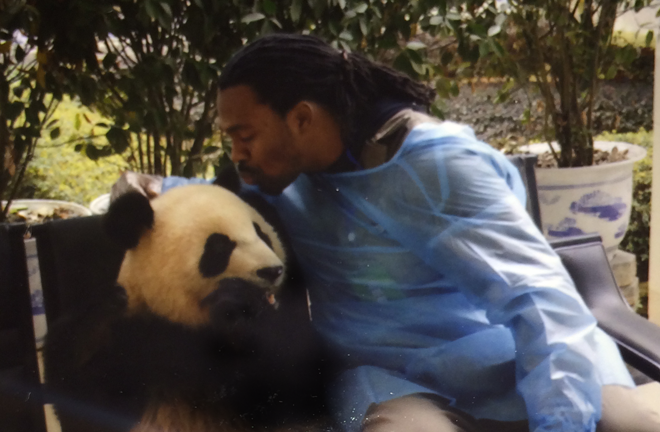
From what I observed, they are very gentle animals. I had the chance to sit down and take a cool picture with the three-year-old panda bear. But we know they’re not always that cuddly and nice. They’re very temperamental. If you rub their ears and if you get close to their mouths, for some reason, it really ticks them off. (I never found out why.) So I made sure not to be on the other end of that story. But it was a great experience and one that I’m glad I decided to do.
I decided to hang around Chengdu for the night after visiting the pandas, and I had a fun night out there. I went down to their downtown area to hang out and check out the nightlife scene. I popped my head in a karaoke lounge, and it was pretty cool. I was just sitting there, this big American guy, hanging out in the lounge, and they’re just having the time of their life singing karaoke.
I didn’t understand any of the words, because of course they’re speaking and singing in Mandarin. But I could definitely feel the warmth and the pleasantry of the people through their body language and their kind gestures.
That was one of the things I enjoy most about traveling: you get a chance to meet a lot of good people, learn new things about them and sit down and communicate. There’s a language barrier, but I tend to find out that people, we all just want to enjoy our life and be able to love people and be loved.

